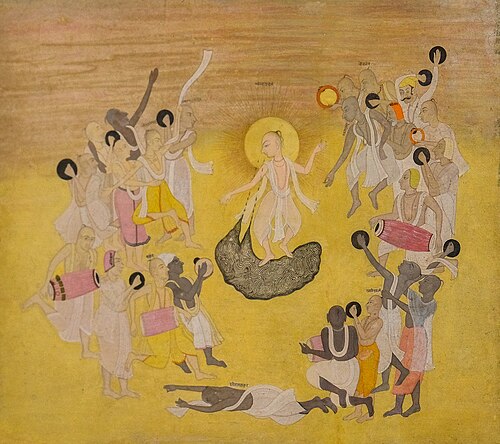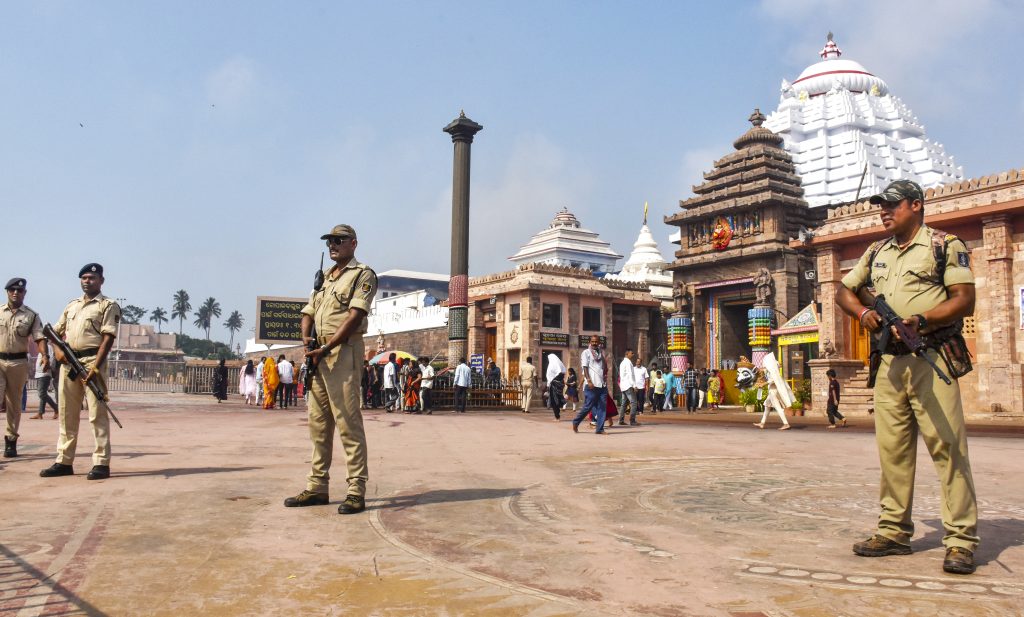Temple Politics and Attack on Migrants Are Escalating Tensions Between Bengal and Odisha
On May 4, prominent Trinamool Congress spokesperson Kunal Ghosh wrote on social media that the time had come for raising questions afresh on the disappearance of Chaitanya ‘Mahaprabhu’, the 15th-century spiritual leader and social reformer from Bengal who founded Gaudiya Vaishnavism.
“Was Lord Chaitanya killed? What happened to him in Puri? A police investigation is perhaps out of the question. But an investigation can surely be conducted under the leadership of a retired judge, involving historians, researchers and specialists,” Ghosh, a former Rajya Sabha member, wrote.
He argued that while there have been many investigations over ‘Netaji’ Subhas Chandra Bose’s disappearance, investigations on the disappearance of Chaitanya, another ‘son of Bengal’s soil’, must be initiated.
Over the past decade of the dominance of Hindu nationalist identity politics with religious majoritarianism, India has seen many medieval characters being dug out of their graves to use them for building contemporary political narratives. Drawing one of Bengal’s best-known spiritual leaders into the present political contests, Bengal chief minister Mamata Banerjee’s TMC party has now sharpened its Bengali ethnic identity politics.

Kisangarh painting of Chaitanya dancing in a puddle of his own tears surrounded by followers, c. 1750. Photo: Wikimedia Commons.
There is only one discernible reason why Ghosh dragged Chaitanya into the current political slugfest between the TMC and the Bharatiya Janata Party (BJP): there exists long-held belief in the speculation that Chaitanya was killed by the priests of Puri Jagannath temple after he entered the premises. The priests then apparently spread the story that Chaitanya had merged into the deity Jagannath.
There is no evidence to support such a theory, but conflicting narratives of his disappearance in 1533 allowed the murder claim a rather long life.
Now that the Puri Jagannath temple authorities and the state’s BJP government have taken offence at the Bengal government naming the new state-sponsored Jagannath temple in Odisha-bordering beach town of Digha as Jagannath Dham, the TMC and Bengali ethnic rights groups seems to have found it a good opportunity to rekindle the old, rather inexplicable grudge against the Puri priests.
A temple in Digha
The Digha Jagannath Dham, formally Jagannath Dham Sanskriti Kendra (cultural centre), is a 213-foot temple. It is a replica of the 12th-century Puri shrine but bigger in size. It was consecrated on April 30 in Digha, about 350 kilometres northeast of Puri, in Banerjee’s presence. A controversy had already started brewing over the consecration ceremony of the Digha temple, as two organisations of Puri Jagannath temple servitors had warned their members against participating in the Digha temple’s consecration ceremony.
However, over 50 servitors from the Puri Jagannath temple, including Ramakrushna Dasmohapatra (also known as Rajesh Daitapati), the secretary of the Daitapati Nijog, an organisation of servitors, joined the Digha ceremony. Dasmohapatra supervised the consecration ceremony.
Many controversies gathered ground in Odisha soon after. Initially, news spread that the idols were made of surplus sacred neem wood from the Puri Jagannath temple. The Puri temple authorities reacted strongly to it, saying that the wood meant for idols at the Puri temple are for the Puri temple alone.
Others claimed that the Digha temple had stone idols. Stone idols of Jagannath, Balabhadra and Subhadra had no religious sanction; they must be made of neem wood.
Dasmohapatra told the media that the idols were made from neem wood under his supervision at Puri. “I then took the idols to Digha for the inaugural ceremony,” he said. He said the stone idols were kept in the temple premises until the consecration ceremony. Since then, they have been removed and the wooden idols are being worshipped.
This brought him under fire. Odisha law minister Prithviraj Harichandan asked the Puri Shree Jagannath Temple Administration (SJTA) to conduct an inquiry to find out if the surplus sacred wood from the Puri temple was used for the Digha idols.
In the face of the controversy, Dasmohapatra clarified that he took neem wood idols from Puri to Digha, but the wood did not belong to the Puri Jagannath temple. Later the SJTA investigation affirmed the same. CM Banerjee slammed the allegation of unauthorised usage of Puri temple woods.

Police personnel stand guard at the Jagannath Temple on May 9, 2025. Photo: PTI
'She did it out of ego'
Nevertheless, the Puri Jagannath temple chief servitor Daitapati Bhabani Das Mohapatra’s scathing attacks on Banerjee triggered sharp response from Bengal. He told the media that naming the Digha temple a 'Dham' was “a huge crime on the part of Bengal chief minister Mamata Banerjee.”
According to him, religious scriptures talk about only four Dhams – Puri, Badrinath, Rameshwaram and Dwark – and there cannot be a fifth or a sixth Dham. He alleged that the Banerjee government neither consulted them nor the Gajapati Maharaja (the hereditary king of Puri), the Odisha government, or the Puri Sankaracharya.
“She did it out of ego. Why didn’t she think of establishing a Jagannath temple earlier? I call it a political stunt because she knows her days as Bengal’s ruler are going to end,” Mahapatra said, his choice of words highlighting its political overtone. “What she has done (in Digha) is against Hindu shastra and a conspiracy.”
Also read: Mamata's Jagannath Dham: State-Funded Digha Temple Raises Concerns About Secularism
'Any place of pilgrimage is a Dham'
Banerjee found support from prominent religious leaders in West Bengal. Radharaman Das, vice-president and spokesperson of the International Society for Krishna Consciousness (ISKCON), a global Vaishnavite organisation headquartered in West Bengal, called the controversy around the naming as ‘unfortunate’ and ‘extremely sad’.
Das argued that scriptures say that wherever god resides can be called a Dham. While there are four chief Dhams, other places are also called Dham, such as the Vrindavan Dham in Uttar Pradesh or Sridham Mayapur and Nabadwip Dham in West Bengal.
“Any place of pilgrimage can be called a Dham. When the consecration has been completed, when life has been invoked in the idols, when Lord Jagannath has become present, how can that place remain ordinary? Those questioning the naming as Dham are doubting the god,” said Das, who also served on the Board of Digha Jagannath Temple Trust.
On May 6, CM Banerjee herself took potshots at the anti-Digha temple campaign in Odisha. “They don’t raise questions when Mamata Banerjee builds the skywalks at Kalighat temple and Dakshineswar temple or worships Durga and Kali. But some seem to be feeling rancorously jealous over the Digha temple,” she said.
She sought to remind everyone that the state sends potatoes to Odisha when it faces a shortage, along with engineers whenever cyclones destroy Odisha’s electricity network. “Bengalis make up the largest chunk of Puri pilgrims. What, then, is your problem if we build a Jagannath Dham of our own?” she said. “Why are they so jealous about Jagannath Dham?”

The Jagannath Temple in Puri. Photo: Wikimedia Commons CC BY-SA 3.0
'Attacks on Bengalis'
Banerjee then swiftly switched to the other topic brewing tension between Bengal and Odisha – incidents of attacks on Bengali-speaking migrant workers, mostly Muslims, in different parts of Odisha, accusing them of being Bangladeshis.
“Why are you beating up our people? I have information that anyone speaking Bengali in Odisha is being thrashed,” she said.
Over the past two weeks, tension had been rising over multiple incidents of attacks on Bengali migrant workers in Odisha. Two TMC MPs, Yousuf Pathan and Samirul Islam, have written to Union Home Minister Amit Shah, demanding that the security of the Bengali migrants is ensured.
Besides, Bangla Pokkho, a Bengali ethnic rights group, has been intensifying an anti-Odia campaign, citing the atrocities against migrant workers in different BJP-ruled states, including Odisha, Gujarat, Maharashtra and Uttar Pradesh. This organisation has been raising the issue of attacks on Bengali migrants in Odisha since last year, when multiple such incidents happened.
After the Digha temple controversy broke out, they launched a sustained campaign calling for a boycott of Odisha as a travel destination.
“Bengal’s son Chaitanya Mahaprabhu was killed in Puri. Justice continues to elude. Bengali migrant workers and traders are now under attack in that same Odisha,” Bangla Pokkho wrote in a post, calling for ‘starving Odias to death’ by boycotting them. It was shared more than 300 times within six hours. “Boycott Odisha until and unless the attacks on Bengalis stop and the killers of Chaitanya Mahaprabhu are brought to justice,” they called in another.
The organisation staged a demonstration outside Utkal Bhavan in Kolkata to protest attacks on and harassments of Bengalis in Odisha. "If Bengalis get attacked in Odisha, should Odias in Bengal be spared?" they asked in a social media post.
However, it’s the narrative around Chaitanya that seemed to have caught broader imagination. Siddhabrata Das, who heads another Bengali ethnic rights organisation, Jatiyo Bangla Sammelan, wrote in a Facebook post that Chaitanya was most likely killed in Puri and evidence should be properly examined. Some social media users highlighted how Chaitanya-researcher and author Joydeb Mukhopadhyay, who was investigating different narratives around Chaitanya’s disappearance, had an unnatural death in Puri, alleging that the local priests killed him to suppress the truth about Chaitanya.
Parties step in
The BJP did not stop its bid to delegitimise the Digha Jagannath Dham. After Puri Govardhan Math's Sankaracharya Nischalananda Saraswati said that Sri Jagannathpuri in Utkal is 'the Sri Jagannath Dham' and that "the replication of this historical fact elsewhere is completely inappropriate," Suvendu Adhikari expressed his 'complete agreement' with him, saying that 'the holy abode of Mahaprabhu Shri Jagannath Ji is definitely located in Utkal.' Odisha was historically known as Utkal.
After the SJTA suspended Rajes Daitapati from temple activities for a month for his association with the Digha temple, Suvendu Adhikari welcomed the 'decisive action in the light of his unethical involvement' in the Digha temple, holding that the servitor had "deeply hurt the religious sentiments of millions of devotees worldwide."
"He (Daitapati) got influenced by Mamata Banerjee and provided unauthorised guidance for the replication of Puri Mahaprabhu Shree Jagannath Dham’s sacred rituals and traditions, which later led to absolutely inappropriate misleading campaign by the local administration, by projecting the Digha Cultural Centre as a site which would rival the Puri Mahaprabhu Shree Jagannath Dham," Adhikari wrote.
The TMC's East Midnapore district leader Akhil Giri took potshots at Adhikari. "The BJP, by dragging our deities into politics, has insulted gods. Besides, they also proved they are anti-Bengali," he said.
The TMC has treaded the path of identity politics cautiously. It has soft-pedalled on Bengali identity politics. Unlike Dravidian parties, the TMC has not gone for strong Bengali ethnic polarisation because the party feared it could result in ‘reverse polarisation’ in favour of the BJP among the state’s Hindi-speaking electorate. Hindi-speaking people make up 7% of the state’s population and play a crucial role in determining the results in over two dozen assembly seats.
However, the TMC does not need to bother about such reverse polarisation when it comes to Odisha-bashing, as the state does not have any significant Odia-speaking population.
This article went live on May fifteenth, two thousand twenty five, at forty-two minutes past eight in the morning.The Wire is now on WhatsApp. Follow our channel for sharp analysis and opinions on the latest developments.




